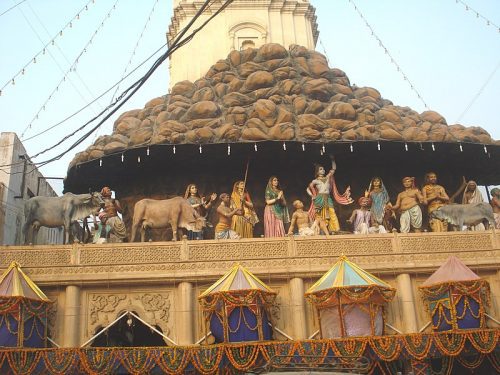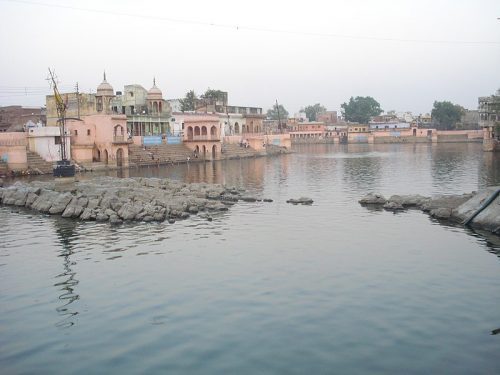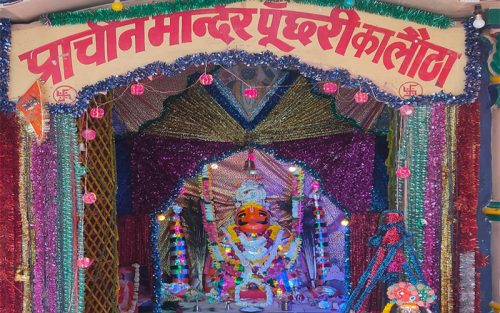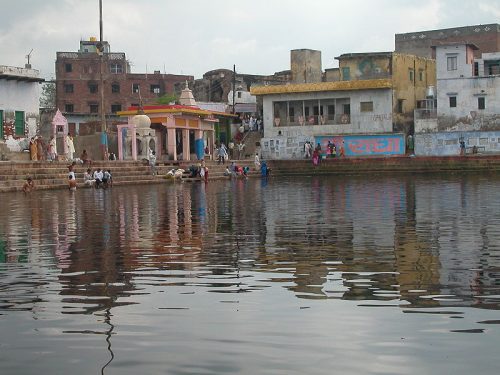Explore the spiritual wonders of Govardhan Parikrama in Vrindavan, a sacred journey through historical spots, legends, and divine experiences. Discover its rich heritage.

Deep within the lush forests of Vrindavan in Uttar Pradesh lies the sacred Govardhana Mountain peak. According to legend, Govardhana emerged from Krishna’s heart in Goloka to fulfil Śrī Radha’s wish for a beautiful setting for their pastimes. Legends say that Govardhan Parvat, Yamuna, and Braj Bhumi are the only three things that have existed since the time of Sri Krishna.
Known as Krishna’s supreme servant, Govardhana offers a fairy-tale playground for the Lord and His companions, where cows, gopas, and gopis find endless joy. To protect the Vrajavasis from Lord Indira’s wrath, seven-year-old Krishna lifted Govardhana like an umbrella for seven days.
Since then, devotees have walked around this sacred mountain as an act of worship. Govardhan Hill, made of sandstone, stretches 21 kilometres in perimeter and stands 80 feet high. Located in Aanyor, Mathura, it is also home to the GiriRaj Temple, an important Hindu pilgrimage site and ancestor god for many families.
The parikrama around Govardhan Hill is about 23 kilometres and takes around 5-6 hours to complete. It starts from Manasi-Ganga Kund and, after worshipping Lord Harideva, leads to Radha Kund Village. From there, the Road guides devotees along the parikrama path.
For those performing dandavata parikrama, the journey can take weeks or months. In this practice, devotees lie flat on the ground to offer homage to the Lord. A person marks the spot where the devotee’s fingertips touch the ground while prostrating, and the process is repeated from there until the entire parikrama route is covered. Some sadhus perform 108 homages at one spot, completing 108 dandavat parikramas.
The ritual of the Parikrama is considered even more sacred if performed with milk. Devotees carry a pot with a hole at the bottom, filled with milk, in one hand, and another pot with incense smoke (dhoop) in the other. A person, often a family member, accompanies the devotee to refill the milk pot until the parikrama is finished.
Why is Govardhan Hill considered sacred?
The mythological significance of this pilgrimage dates back to when Lord Krishna lifted Govardhan Hill on his little finger to shield the people from the wrath of Lord Indra, the rain god for 7 days to break the ego of Indra and to make Brijwasi understand that Govardhan Hill is the ultimate protector of them. This miraculous event made Govardhan a blessed hill, and it is believed that those who circumambulate it will be absolved of all sins.

Another story connects Govardhan Hill to the Treta Yuga, the era of Sri Ram. When the Ram Setu bridge was being constructed at Rameshwaram for Sri Ram’s army to cross the sea, monkeys were tasked with gathering mountains for the bridge. Hanuman was carrying a mountain from the Himalayas when Nal and Neel, the bridge’s architects, announced that no more stones were needed. They instructed everyone to place the mountains they were carrying wherever they were. Hanuman, who was in Braj Bhumi at the time, left the hill there before proceeding to Sri Lanka.
This tale links the stories of the 7th and 8th Avatars of Vishnu—Ram and Krishna—making Govardhan Hill even more revered, as it is associated with two divine incarnations.
Govardhan Parikrama – a walk of divinity:
Let’s now go through each of the major attractions along the 21-kilometre parikrama, providing a brief background for each one.
Danghati temple (Starting point)
Pilgrims begin the Parikrama at Daanghati Mandir. The temple façade, which depicts Krishna carrying Govardhan Parvat on his little finger, is a relatively new addition.
Daanghati Temple gets its name from the Daan, or tax, that young Krishna used to collect from the Gopikas who wished to perform Puja. On one occasion, they offered Radha as Daan, fulfilling Krishna’s desire.
The temple is a complex with many smaller temples. A rock, decorated to appear lifelike, is the primary object of worship throughout the village.
Mansi Ganga
Near Daanghati temple, there is Mansi Ganga a sacred lake situated in the centre of the village. According to legend, Nand and Yashoda, the foster parents of Sri Krishna, once desired to visit the Ganges. They stopped here for the night during their journey, and by morning, Krishna had miraculously brought the Ganges to this spot from his mind, giving it the name Mansi Ganga.
Chakreshwar Mahadev Temple
Located 1.2 km along the Parikrama Marg, pilgrims visit the Chakreshwar Mahadev Temple to pay homage. This is one of the most remarkable temples along the entire trail. It is a Shiva temple featuring five Shivalings arranged in the shape of a Chakra. A carved stone behind the temple depicts the story of Krishna lifting Govardhan Parvat on his finger. According to legend, when Krishna lifted the mountain, water began to gather in a pit. Shiva appeared in the form of a Chakra (wheel) to drain the water, and this temple commemorates that event.
Poonchari Ka Lautha Temple:
Continuing along the parikrama route, pilgrims come across the famous Poonchhari ke Lautha Ji ka Mandir in Anyaur Village. But who is Lautha Ji?

Lautha Ji was a friend of Sri Krishna, and they practised wrestling together as children. When Krishna had to leave Braj Bhumi for Dwarka, he asked Lautha to accompany him. However, Lautha did not want to leave Braj Bhumi and vowed to live without eating or drinking until Krishna’s return. Krishna blessed him to live a healthy life even without food. The temple is small but vibrant, attracting many visitors who come to make wishes. The murti (idol) here resembles a wrestler with a big moustache, reflecting Lautha Ji’s persona.
Mukharvind
Just 4 km ahead, pilgrims arrive at the charming village of Jatipura, renowned for the Mukharvind Temple. This village is celebrated for its open temple, where devotees offer milk to a colossal rock, believed to be the face of Giriraj Ji. Throughout the day, the rock undergoes various adornments, a practice known as Shringar.
The narrow lane leading to the temple is bustling with vendors selling milk. Atop the hill, an impressive depiction of Krishna lifting the mountain adds to the temple’s enchanting atmosphere.
Govardhan Parvat Chhoti Parikrama
Let’s commence the Chhoti Parikrama of Govardhan Parvat and delve into its significance and beliefs.
The Chhoti Parikrama of Govardhan Parvat spans 9 km. This sacred journey begins just after the Jatipura Mukharbind Temple.
Radha Kund and Shyam Kund:

As pilgrims proceed along the Chhoti Parikrama route, they reach the sacred Radha Kund and Shyam Kund. Located in the village of Arita near Govardhan Hill, Radha Kund and Shyam Kund are two sacred ponds revered by Vaishnavas. Situated 3 miles northeast of Govardhan Hill, these ponds are considered the eyes of the hill and have witnessed many sweet pastimes of Lord Krishna and Radha.
Braj, associated with Lord Krishna’s leelas, holds great significance, and every place here is deeply connected to his life. Radha Kund and Shyam Kund are especially significant in this regard. According to legend, Krishna killed the demon Arishta, who had come disguised as a bull, to protect his friends. Following this, Krishna was cursed for killing a bull, which led him to create a kunda by striking his heel on the ground and summoning all holy places to fill it with water. Radha also created her own kunda with her bracelet, which Krishna filled with the same holy waters.
Both Radha Kund and Shyam Kund contain the purest and most sacred water in the world. Krishna promised Radha that he would bathe in Radha Kund every day, giving it a special place in his heart.
Pilgrims from around the globe come to these kunds to take a holy dip, seeking to cleanse themselves of sins. As prime centres of salvation and spirituality, Radha Kund and Shyam Kund hold a unique and cherished place in the hearts of devotees visiting the Braj region.
The Govardhan Parikrama is not just a physical journey but a deeply spiritual experience. Each spot along the path holds a unique story and significance, enriching the devotees’ understanding of their faith. Through the circumambulation, devotees find eternal peace, connecting with the divine and the rich tapestry of Hindu mythology and spirituality. This journey through the sacred sites of Govardhan Parikrama offers solace, reflection, and a profound sense of devotion, leaving an indelible mark on the hearts of those who undertake it.
Kusum Sarovar
Continuing on the Chhoti Parikrama route, pilgrims encounter the enchanting Kusum Sarovar, situated just 2 km from Govardhan in Mathura. This serene reservoir is 60 feet deep and 450 feet long, steeped in mythological tales, particularly those of Radha and Krishna.
Legend has it that Lord Krishna would secretly visit Kusum Sarovar to meet Radha. Radha and her friends would come here to pick flowers for Krishna, adding a romantic allure to this picturesque spot.
Kusum Sarovar’s beauty is captivating, with its surrounding stairs enhancing its charm. Locals believe that the lake holds the mystical Paras stone and Nagmani, adding an air of mystery to its allure. This captivating blend of natural beauty and mythological significance makes Kusum Sarovar a must-visit for devotees and tourists alike.
Completing the Parikrama is more than just a physical journey; it’s a spiritual pilgrimage that connects devotees with the divine essence of Lord Krishna. As you traverse the sacred 21-kilometre path, every step is a reminder of the mythological tales and the profound spiritual significance embedded in this ancient practice.
From the serene waters of Mansi Ganga to the enchanting allure of Kusum Sarovar, each site along the Parikrama route offers a unique glimpse into the divine pastimes of Radha and Krishna. The peaceful ambience of Radha Kund and Shyam Kund, coupled with the spiritual energy of Govardhan Hill, provides a deeply enriching experience for all who undertake this sacred journey.
As you conclude your Parikrama, having completed the full circle, there’s a sense of fulfilment and inner peace. The blessings received and the spiritual merit earned are believed to bring immense benefits, both in this life and beyond. Whether you’re a devout follower or a curious traveller, the Parikrama leaves an indelible mark on your soul, inviting you to return and relive the divine journey once more.
In the end, the Parikrama is not just a ritual but a testament to unwavering devotion and faith, a journey that transforms and uplifts, leaving you with cherished memories and a heart full of divine love and gratitude.
Rules of Govardhan Parikrama
To start the sacred journey, it’s essential to know the rules:
Start and End with Respect: Before beginning the Parikrama, offer your respects to Mount Govardhan. Complete the Parikrama at the same spot where you started.
Purifying Bath: It is believed that those who wish to start the Parikrama must first take a bath in the Mansi Ganga.
Complete the Journey: Never leave the Parikrama incomplete. Ensure you finish what you start.
Best Time for Govardhan Parikrama
Devotees usually perform the Parikrama barefoot, making the timing crucial:
- Daytime: From December to March.
- Nighttime: From April to November, as the daytime temperatures can be quite high during summer.
Things to Remember
Beware of Monkeys: The monkeys in the Vraj region are notorious for snatching spectacles and food items. You might see people offering them food in exchange for their belongings!
Try the Lassi: Don’t miss out on the delicious Lassi of Vraj Bhumi. After all, you’re in the land of Makhanchor (the butter thief), so savour the local delicacies!
Read more: Latest



